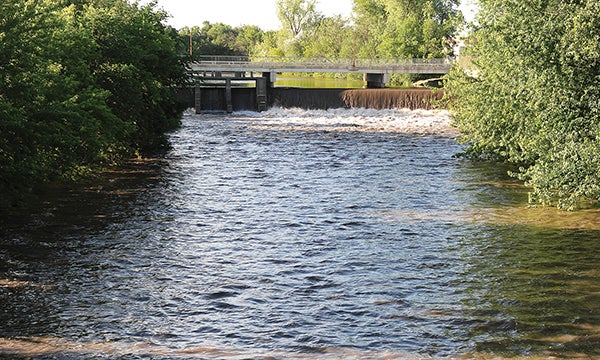State report outlines high nitrate levels in Cedar, but CRWD officials not surprised
Published 10:57 am Thursday, June 27, 2013

The Cedar River flows over the dam as it comes out of Mill Pond. A recent Minnesota Pollution Control Agency report claims that cropland runoff is responsible for as much as 95 percent of the nitrate load in the Minnesota, Missouri and Cedar rivers.
By Matt Peterson and the Associated Press
MINNEAPOLIS — State regulators cited agricultural tiling as a major reason for rising nitrate levels in southern Minnesota surface waters, and a local watershed specialist said the Cedar River has one of the highest nitrate levels in the state.
A Minnesota Pollution Control Agency study found more than 70 percent of the nitrates in surface water in intensively farmed southern Minnesota come from cropland, where anhydrous ammonia and other nitrogen compounds are commonly used as fertilizer. The rest comes from sources such as wastewater treatment plants, septic systems, urban and forest runoff, and the atmosphere.
To Justin Hanson, resource specialist with the Cedar River Watershed District, the overall report isn’t surprising.
“We knew this was coming,” Hanson said. “There has been so much talk about nitrates for several years.”
After looking at maps from the study, though, he found local results quite surprising and disturbing.
“Our area is one of the highest that happens to be in the state,” Hanson said about nitrate levels. “We’re a little concerned about that.”
During the past few years, CRWD has focused on high turbidity, the amount of suspended sediment and solids in waterways. CRWD employees have known about high nitrates; however, there has not been well-defined state standard for nitrate levels.
“We’ve been working with standards they have for turbidity, but there has never been a set standard for nitrate levels,” Hanson said. “Basically, this [study] is the start of that process.”
Drain tiles — the perforated pipes that farmers install a few feet under the surface of their land to carry away excess precipitation — are the top pathway by which nitrates travel from cropland to streams, the study found. Cropland sources account for as much as 95 percent of the nitrate load in the Minnesota, Missouri and Cedar rivers, and the Lower Mississippi River basin, the study added. Furthermore, the Minnesota River adds twice as much nitrate to the Mississippi River as the Upper Mississippi and St. Croix rivers, which flow through less intensively farmed areas to the north.
High nitrate levels can harm fish and aquatic life, and can pose health risks to humans when they pollute drinking water wells. Nitrates flowing down the Mississippi from Minnesota are blamed for contributing to the oxygen-starved “dead zone” in the Gulf of Mexico, which the MPCA said is currently the size of Massachusetts.
Yet farmers are well aware of the issue, too. Arvid Jovaag, a sustainable farmer south of Austin would like to see more testing, especially at the ends of tile lines. Among the need for more wetlands, nitrogen ponds and grass buffer strips to catch agricultural runoff, Jovaag and others are concerned about fertilizer application.
“We do need nitrogen to grow the crops, but there are different ways of application and different timings of application,” Jovaag said.
Jovaag indicated farmers may need to start focusing on more responsible ways of applying fertilizer, such as during the growing season, called side-dressing. He added this year’s excessive rain has likely washed away a lot of fertilizer, too. The solutions aren’t easy.
“We all need to work on that, myself included,” Jovaag said.
Farmers have become more efficient at applying fertilizers with precision equipment and reducing their usage, but raising water quality significantly will be expensive, the report said.
Doug Albin, a Minnesota Corn Growers Association board member from Clarkfield in southwestern Minnesota, said in an interview that he’s more optimistic than the MPCA, and added that he’s enthusiastic about seeing what farmers can do to address the nitrate problem while keeping production up.
“The problem is we’ve never been able to quantify and identify the problem,” Albin said. “Farmers are great problem solvers. So now that we’ve identified the problem we can sit down and examine our farming operations.”
Hanson agreed with that statement, as he said the findings offer another opportunity to work closely with local farmers, who have been very cooperative in the past.
Environmentalists noted the study found nitrate levels exceeding the state’s safe drinking water standards at 27 percent of the monitored sites. They said the findings show the state’s current approaches aren’t working. The MPCA used monitoring results from more than 50,000 stream samples from across Minnesota. It found low nitrate levels in the north, higher in the southern part of the state, and high to very high in south-central Minnesota. The agency also worked with University of Minnesota researchers to examine the pathways by which nitrates get into surface waters.
To address the problem, Minnesota state agencies are working on a strategy for reducing the state’s contribution to the “dead zone.” Minnesota contributes the country’s sixth-highest nitrate load to the gulf, the report said.
The U.S. Department of Agriculture earlier this month announced a voluntary pilot project for four small Minnesota watersheds that will offer farmers incentives to reduce water pollution from their operations in exchange for protection from tighter future regulations. Hanson said the Cedar River watershed is not one of them. Controlling water pollution from agriculture has been a political and technical challenge. Because agriculture is exempt from the federal Clean Water Act, officials have emphasized voluntary measures so far.





